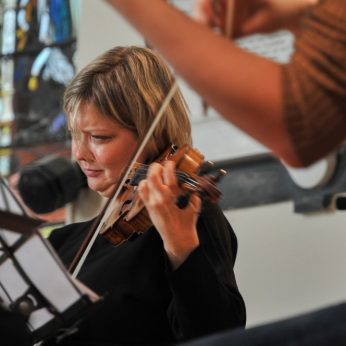Composer: Wolfgang Amadeus Mozart (b. 1756 - d. 1791)
Performance date: 26/06/2023
Venue: St. Brendan’s Church
Composition Year: 1779
Duration: 00:30:07
Recording Engineer: Gar Duffy, RTÉ
Instrumentation: 2vn, va, vc
Instrumentation Category:String Sextet
Artists:
Alina Ibragimova -
[violin]
Mairead Hickey -
[violin]
Emma Wernig -
[Viola]
Seamus Hickey -
[viola]
Leonard Elschenbroich -
[cello]
Christopher Marwood -
[cello]

Grande Sestetto Concertante – Anonymous Arrangement of Sinfonia Concertante in E flat major K364. [1779/1807]
1. Allegro maestoso
2. Andante
3. Presto
It must have been anything but easy to transform the Sinfonia Concertante for solo violin and viola and an orchestra consisting of two oboes, two horns, divided violins, cello and double bass into a chamber music work for six string instruments. Naturally this meant reducing rather than arranging, particularly when the two solo parts had to be seamlessly integrated into the six string ensemble. Mozart’s original keys, tempi, dynamics and expression markings were retained in all three movements, but the loss of the orchestral colour drastically changed the demands of the music. While the scordatura tuning of the solo viola was dispensed with, the distribution of the solo parts went a step further; their themes, ornaments and cadenzas were not simply transferred to the first violin or viola part, but were distributed among five of the six string parts. Only the bass part of the second cello was not included in this treatment.
As a result of this, we have a new chamber work, albeit a second-hand one. There are still a lot of flabby performances and recordings of the original orchestral version, with over-large orchestras playing as though Mozart was an early version of Richard Strauss, so it may well be revelatory for some to hear this slimmed-down version. The finely cast transparent structure of the first movement works extremely well as chamber music, as does the deeply felt and brooding C minor Andante. In the presto finale the absence of the wind, especially the horns, is more keenly felt, but the brisk tempo can overcome even this slight deficiency. For those who know the original well there is the pleasure of measuring one version against the other and for those unfamiliar with one of Mozart’s most sparkling works it is a lean and spirited introduction.
Francis Humphrys
Copyright © 2025 West Cork Music. All rights reserved.
Designed and developed by Matrix Internet